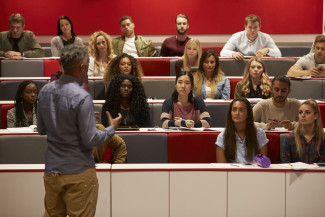
Johns Hopkins UniversityEst. 1876
America’s First Research University
Education in the Digital Age: A Look at the Progression of Technology in Education with Norm Friesen

I went to school at the dawn of the microcomputer. These were expensive, immobile boxes that only responded to coded commands. Today I hold a smartphone in my hand that is over 10,000 times more powerful and infinitely more flexible. This incredible technological revolution, however, is all but invisible when I now go back to schools as a Prof. in Educational Technology. Yes: There are teachers using interactive whiteboards, and students sneaking peeks at their phones or using a tablet. But I still see teachers covering material via lectures and students using textbooks—just as they do in my own university. I can’t help but ask: “Why has education changed so little when media and technology have changed so much?”
I wasn’t satisfied by the standard explanations: That we’re at the cusp of an educational revolution (we always are) or that educators are “laggards” (they work very hard). Instead, I looked at how questions of change and stability are understood by people without a stake in the game, who focus more on a well-documented past than on an uncertain future. I looked to historians, and in their accounts I found incredible stories about teaching and textbooks stretching back centuries that can tell us much about the present. I discovered that the university lecture began near the end of Middle Ages as a way of copying and preserving texts. I learned that it was only about 200 years ago, well after the introduction of the printing press, that Romantic era scholars finally reimagined the lecture as a momentous intellectual “event.” I saw that textbooks have a similar history: Different versions emerged about 700 years ago, and of course spread like wildfire after Gutenberg. But was it again the Romantics who reimagined the textbook as engaging the reader with personalized questions and conversational writing. Finally, I also discovered that “tablets”—things you hold in your hand and “inscribe” with a finger or stylus—have been popular in “education” for a very long time, well over 4000 years.
What do these discoveries tell us about education today and tomorrow? They tell us that change does indeed happen, but that it occurs at a time-scale and in response to factors we’ve overlooked. One famous French historian describes this time-scale as the longue durée, as being 100s if not 1000s of years long—and as very different from the pace of “our daily life” and “hasty awareness.” The factors motivating this glacial change appear to have very little to do with technological inventions or revolutions, but with broader and much more gradual cultural changes. After all, it is not the work of Gutenberg or Edison, but of the Romantics—poets, philosophers and free-thinkers—who finally gave the lecture and textbook their modern shape.
Looking back still further, I saw that education is not opposed to technology or change. Instead, it is deeply committed to the most basic of technologies and the changes they’ve undergone: To text and writing, and to the evolving tablets and tools used to master it. Our phonetic alphabet has been around, virtually unchanged, for over 2000 years, and the “read and write interface” of the tablet has been in use much longer. Mastery of this these tools and systems, moreover, does not happen spontaneously; it does not develop naturally from our biology. It takes years of hard work from both teacher and student, and it continues—with essays, computer code and equations—well into college. This mastery is a cultural achievement, and with each new generation (every thirty years) this achievement has to be repeated, right from the start. Since writing (of whatever kind) has been around only about 4,500 years, this repetition or re-creation has only happened 150 times in human history. This difficult and tenuous achievement, I believe, is the core of education, with educational innovation occurring only at the periphery. As we rethink the lecture and the textbook today, say, as a gripping TED-Talk or an personalized digital experience, we would do well to recognize the dynamics of the longue durée, and the way that long-lived forms like the textbook, the lecture and the tablet work within it.
Norm Friesen is a professor in the Department of Educational Technology at Boise State University. He is the editor and translator of Forgotten Connections: On Culture and Upbringing and the editor of Media Transatlantic: Media Theory in North America and German-Speaking Europe. He is most recently the author of The Textbook and the Lecture: Education in the Age of New Media


